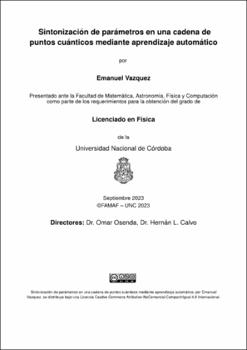| dc.contributor.advisor | Osenda, Omar | |
| dc.contributor.advisor | Calvo, Hernán Laureano | |
| dc.contributor.author | Vazquez, Emanuel Andrés | |
| dc.date.accessioned | 2024-04-16T13:26:14Z | |
| dc.date.available | 2024-04-16T13:26:14Z | |
| dc.date.issued | 2023-09 | |
| dc.identifier.uri | http://hdl.handle.net/11086/551434 | |
| dc.description | Tesis (Lic. en Física)--Universidad Nacional de Córdoba, Facultad de Matemática, Astronomía, Física y Computación, 2023. | es |
| dc.description.abstract | Un punto cuántico es un sistema estructurado artificialmente que se puede llenar con electrones (o huecos) y además puede acoplarse con barreras de túnel a reservorios macroscópicos, con los que se puede intercambiar electrones. Si bien la física que rige estos mecanismos de transporte de electrones es sencilla para los casos más simples, su complejidad aumenta de manera considerable para sistemas donde el número de puntos cuánticos se incrementa. En este trabajo se busca hacer una regresión utilizando aprendizaje automático y así lograr la predicción de valores para los parámetros. Para esto se creó una base de datos simulando diferentes condiciones la cual se utilizó en el entrenamiento del algoritmo. La misma se construyó generando mapas de corriente (vector de entrada) utilizando diferentes pesos en los voltajes (vector de salida). Para lograr la simulación de corrientes se utilizó la teoría de transporte en tiempo real, reformulada en término de los super operadores de Liouville en la cual se evalúa una expansión perturbativa en el acople entre el sistema local y los reservorios anexados. | es |
| dc.description.abstract | A quantum dot is an artificially structured system that can be filled with electrons (or holes) and can also be coupled with tunnel barriers to macroscopic reservoirs, with which electrons can be exchanged. Although the physics that governs these electron transport mechanisms is simple for the simplest cases, its complexity increases considerably for systems where the number of quantum dots increases. This work seeks to do a regression using machine learning and thus achieve the prediction of values for the parameters. For this, a database was created simulating different conditions which was used in training the algorithm. It was built by generating current maps (input vector) using different weights on the voltages (output vector). To achieve the simulation of currents, real-time transport theory was used, reformulated in terms of the Liouville super operators in which a perturbative expansion is evaluated in the coupling between the local system and the attached reservoirs. Finally, the behavior of the results was explored by adding noise to the currents. | en |
| dc.language.iso | spa | es |
| dc.rights | Attribution-NonCommercial-ShareAlike 4.0 International | * |
| dc.rights.uri | http://creativecommons.org/licenses/by-nc-sa/4.0/ | * |
| dc.subject | Puntos cuánticos | es |
| dc.subject | Teoría de transporte | es |
| dc.subject | Super operadores de Liouville | es |
| dc.subject | Aprendizaje automático | es |
| dc.subject | Parametrización | es |
| dc.subject | Quantum dots | es |
| dc.subject | Transport theory | en |
| dc.subject | Liouville super operators | en |
| dc.subject | Machine learning | en |
| dc.subject | Parametrization | en |
| dc.title | Sintonización de parámetros en una cadena de puntos cuánticos mediante aprendizaje automático | es |
| dc.type | bachelorThesis | es |
| dc.description.fil | Fil: Vazquez, Emanuel Andrés. Universidad Nacional de Córdoba. Facultad de Matemática, Astronomía, Física y Computación; Argentina. | es |





